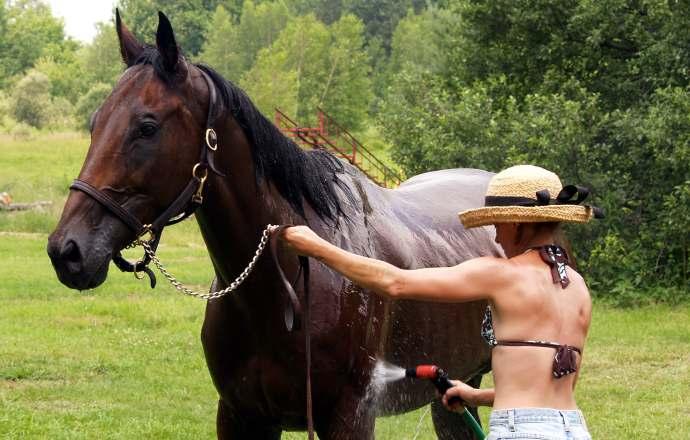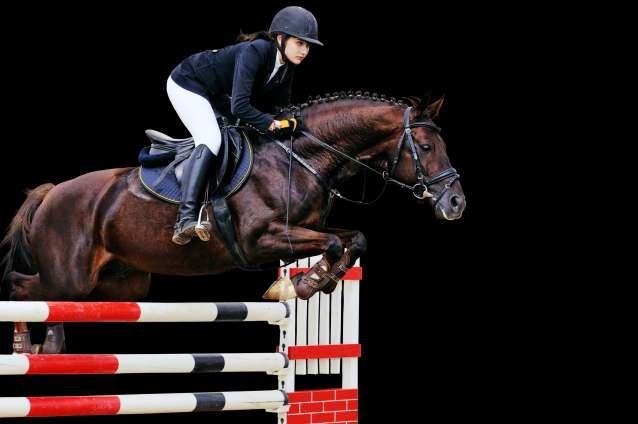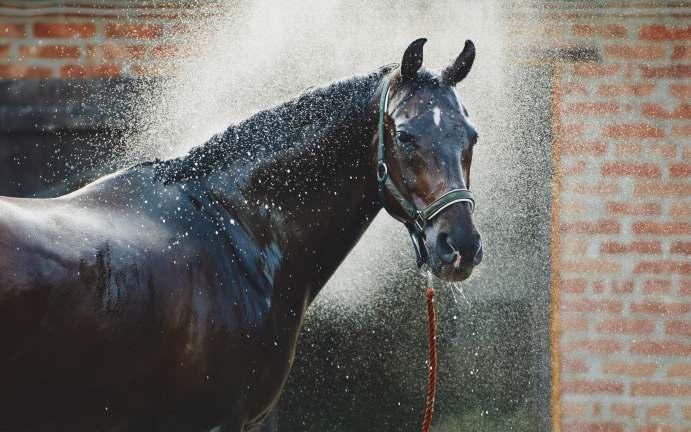
6 minute read
Getting A Horse Used To Water A Beginners Guide
By Carmella Abel | https://equinehelper.com/
Water can be very frightening to a horse that doesn’t have much experience with it. Because of this, I’ve learned that it’s very important to exercise caution as you’re introducing a horse to water for the first time. Whether you want to ride your horse through water, or just give them a bath, this guide may help.
So, how can you get a horse used to water?
You can get your horse used to water by helping them create positive associations with water, desensitizing them to any aspects of water that frighten them, and being patient as you work with them. As your horse becomes more comfortable with water, you can gradually increase their exposure to it.
Getting a horse used to water with a bath If a horse has never been bathed before, they may not like the idea of being sprayed with a hose. I have seen horses truly terrified of water spraying them; if your horse reacts as such, then desensitizing them to this will be very helpful.
Get the horse used to the water with a wet rag. If your horse is particularly afraid of water coming out of a hose, I would first introduce them to water via a wet rag or sponge. All I would do is take the rag and squeeze the water out over the horse’s coat. If the horse tries to step away, I’m going to move with the horse and keep squeezing the water out until the horse stands still. Use the wet rag or sponge all over the horse’s body in order to properly desensitize them to the feeling of water running over their coat.
Get a horse used to water by holding the hose at their feet. Now that you’ve gotten your horse used to the feeling of water running over their coat, it’s time to try it with the hose. When I first go to do this with a wary horse, I’ll simply turn the hose on and hold the stream of water at the horse’s feet. This will allow them to get used to the feeling of the water hitting them as well as the temperature of the water.
Like I did with the wet rag, if the horse steps away from the stream of water at its feet, I’ll move with the horse, keeping the water at their feet. If the horse were to move away and you automatically take the water off of them, you’re teaching them that they can escape it by stepping away. This is why it’s important to be consistent with keeping the water on the horse even if they start moving
Get a horse used to water by slowly moving the stream of water over their body. Once you see that the horse can stand still with the water at its feet, you can move the hose up towards the horse’s body. As you’re doing this, you’ll probably reach points on the horse’s body where the horse wants to step away In these instances, move with the horse as it steps away as you continue to hold the stream of water at the point that made the horse move.
Once you have done these steps and your horse can stand still as it receives a bath, then you have properly desensitized your horse to water being sprayed over them. Desensitizing is an important part of the training process when it comes to horses.
Getting a horse used to riding through water. For some reason, it seems as horses form a disconnect between water being sprayed over them, like in a bath, and simply walking through water. I’ve seen horses have a meltdown at having to walk through a shallow puddle; unfortunately, this isn’t uncommon in the horse world. Going through water is still one of the biggest fears most horses have.
Get your horse used to riding through water by starting with a tarp. If your horse is scared to walk through water then it is most likely scared to walk over most foreign objects. My first goal in dealing with a horse that won’t ride through water is to get the horse to walk over a tarp. A tarp is just as scary as water, it’s bright blue, crunches when the horse walks over it, and it can move in the breeze.
When you train your horse over a tarp, you can do it in a friendly family environment like an arena they’re used to, and you don’t have to worry about falling into the water and getting wet if your horse has a cow. This makes this exercise less daunting for both you and the horse.
I always like to start on the ground before I get in the saddle. I’ll lay the tarp on the ground and lead the horse over to it. In order to approach this assertively with confidence, keep your eyes pointed to where you want to go and apply pressure to the lead rope if the horse balks.
Sometimes horses can pick up on your confidence and they’ll see that there’s no need to worry about an obstacle. If the horse stops and refuses to go over the tarp, keep the pressure on your horse. As soon as the horse steps towards or on the tarp, release the pressure and praise the horse.
By doing this, you’re teaching the horse that the tarp means relaxation and no pressure. Keep this method up until your horse can effectively walk over the tarp.
Getting a horse used to water by going through a puddle. Once your horse can confidently walk over a tarp, it’s time to reintroduce your horse to water Approach the puddle of water the same way you approached the tarp; with assertiveness and confidence. If your horse balks or refuses to go over the puddle, keep the pressure on them.
As soon as the horse makes a step towards the puddle or into the water, then relax the pressure and praise the horse. Walk your horse back and forth through the puddle to help build their confidence going through the water.
Once you have this exercise down, you are ready to face bigger and deeper water obstacles; just keep in mind the method that you used to get the horse over the tarp and through the puddle. I’ve had this method work countless times with many horses.
Things to remember when training your horse through water

Try to stay relaxed and calm
It can be stressful to deal with your horse when they are wary of a certain obstacle. I’ve spent many rides simply working on desensitizing my horse to some random object we came across that they were afraid of In these instances, it’s easy to get overwhelmed and wear your frustrations on your sleeve.
It’s important to remember that horses can pick up on emotions, and they usually tend to mirror the vibe that they sense. If you’re giving off a frustrating vibe, you can make your horse get more nervous and stressed about the obstacle. Staying calm, relaxed, and reassuring, even if you end up working with the obstacle for a while will help you and your horse in the long run.
Check your riding position
If you’re ever on your horse and trying to get them to go through water, it can be easy to focus more on the problem than on your position. However, your position may help you get out of the problem!
Many times, when a rider gets up to an object that their horse is afraid of or refusing to go near, the rider will subconsciously look directly at the obstruction, pull on the reins, and tilt their upper body forward. I’m just as guilty as anyone! This does no good to encourage the horse forward; rather, it communicates to the horse that you’re afraid of the object as well.
Once I noticed the negative effect my position had on the situation, I made a point to correct it the next time my horse faced a scary object. I looked up, sat straight, and held steady soft hands to encourage my horse forward.
https://www.youtube.com/@EquineHelper

Remember to praise your horse
When it comes to horse training, it’s important to recognize even the smallest improvements. If at the start of the training session your horse wouldn’t get two feet from the water, but by the time you end your session your horse can stand at the water’s edge, that’s an improvement!
Praise your horse for even the smallest try, like shifting their weight forward. If that’s the best you can get at that moment, recognize it and let your horse take a breather This will help the horse to see that the situation isn’t as bad as they’re making it out to be in their heads.
As mentioned above, not a lot of horses are fans of water; it takes training and consistency for them to get used to it.

Hi, I’m Carmella. My husband and I started Equine Helper to share what we’ve learned about owning and caring for horses. I’ve spent my whole life around horses, and I currently own a POA named Tucker You can learn more on our website at https://equinehelper.com/ https://www.pinterest.com/equinehelper/ https://www.instagram.com/equinehelper/











